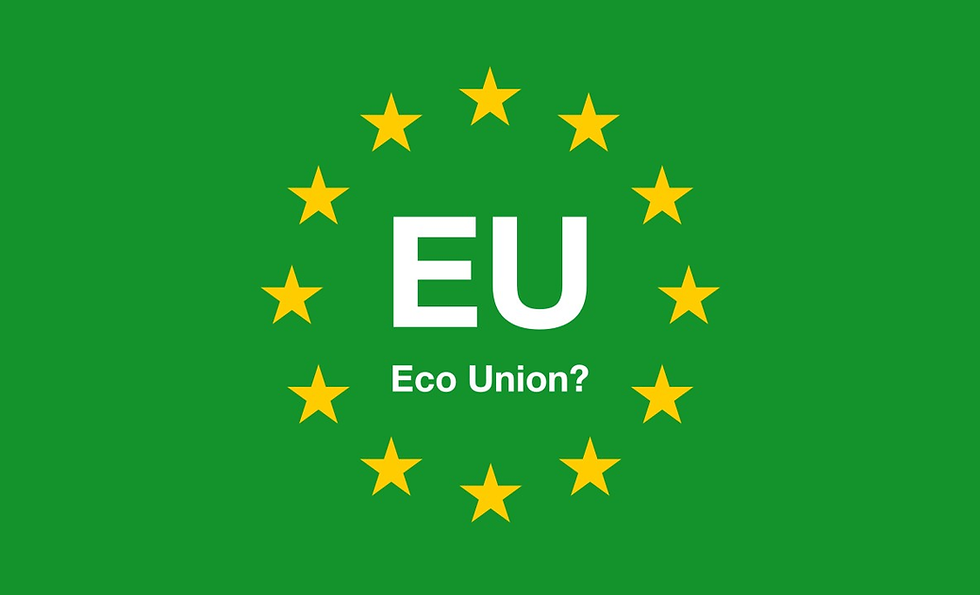The EU’s Response to Greenwashing
- Richard Burchill
- Feb 12, 2024
- 8 min read
The EU’s Response to Greenwashing
Trianon Scientific Communication has invited Dr Richard Burchill, as a guest writer.
Richard Burchill is a Senior Counsel for Macroscrope Strategies, Brussels; Associate Research Fellow United Nations University (UNU-CRIS), Brugge.

Awareness about climate change, environmental degradation, and the need for sustainability is increasing as the impact of climate change continues to affect day-to-day lives around the world.

Increased awareness is a positive development
as it channels thinking and action in a direction that gives more consideration to what action is needed to minimize environmental destruction and promote sustainability.
Greater awareness of the impact of climate change and the need to change behaviour have resulted in both positive and negative forms of behaviour.
The positive changes in behaviour are welcomed as consumers strive to lessen their environmental impact through more informed choices that support sustainability.
The negative impact comes when sales and marketing strategies seek to capitalise on the attention being given to the environment by using misleading or bogus information, which is “greenwashing.”
Greenwashing is a common activity
as companies strive to take advantage of the leading trends in society regarding climate change, but in a way that benefits the company without creating too many extra costs.
The EU is taking action to ensure companies can no longer engage in greenwashing.
A proposal for a Green Claims Directive is currently in the legislative process and is expected to be adopted in the first quarter of 2024, potentially coming into force in 2026.[1]
The Directive is at the intersection of consumer protection and the European Green Deal.
It is designed to protect consumers from the deceptive practices of greenwashing and ensure accurate and accessible information is available for decision-making.[2] The Directive is part of the EU’s wider green agenda and will support the wider purposes of the EU’s efforts regarding sustainability.
The core idea behind the proposed Directive is ensuring transparency regarding the claims being made by ensuring such claims are based on accessible and verifiable evidence.
There is no shortage of advertising claims that seek to show the consumer how the product in question is somehow beneficial to the environment, or at least has not harmed the environment.
Plus, companies are working on improving their overall image and reputation by showing they are leaders in environmentally friendly activities. The most common label attached to these activities is that the product, service, or investment is “green” (blue is also used in some circumstances), with these colour choices being seen as a good thing.
But green or blue is just a colour and not an objective point of reference or a scientific measure that is verified by evidence.
The majority of claims about the green credentials of a product, service, or investment are primarily subjective claims
being made to improve the reputation of what is being offered in the hope it becomes more popular compared to competitors.
Greenwashing goes beyond the normal marketing practice of trying to demonstrate the superiority of a product in relation to competitors, in that it purposely misleads consumers about the environmental performance or impact of a product, service, investment, or the overall reputation of a company.
There are numerous examples of greenwashing where companies are:
Claiming to be “carbon-neutral” or “climate positive” without providing verifiable evidence.
Using vague terms such as “natural”, “organic”, “eco-friendly”, or “green” without defining what they mean or how they are measured.
Highlighting only one aspect of environmental performance, such as energy efficiency or waste reduction, while ignoring others, such as water consumption, biodiversity impact, or social responsibility across the supply and value chains.
Making exaggerated or unsubstantiated claims about the benefits of a product or service for the environment or sustainable development.

Exaggerated or superfluous claims are a common tactic in sales and marketing and are relatively harmless when they involve superficial assessments such as being a “leading” or a “valued” product or company.
No product or service will advertise itself as being “average” or just doing the job like all others in the market.
There is always some positive assertion behind products and services that seek to attract customers and position the company as comparatively better than competitors.
However, with greenwashing, there are concerns that such practices are harmful to consumers, preventing well-informed decisions.
Greenwashing practices further remove incentives for companies to pursue business practices and models that seek to minimize the environmental impact and enhance sustainability - it is easier to make up a position than truly adopt the practice.
The Green Claims Directive will change sales and marketing practices
as any explicit environmental claim now needs to be grounded in verifiable, transparent facts based on accepted methodologies and evidence. The key objectives of the Directive are:[3]
To make green claims reliable, comparable, and verifiable across the EU.
To protect consumers from greenwashing.
To contribute to creating a circular and green EU economy by enabling consumers to make informed purchasing decisions.
To help establish a level playing field regarding the environmental performance of products and services.
The Directive requires companies to prove and substantiate the environmental claims being made across the supply chain of the product. Once the Directive enters into force, all green claims will need to be backed up by transparent evidence that is clearly communicated. Further, third-party verification systems will be established at the national level, which will set out acceptable methodologies for green claims.
Through the introduction of verifiable evidence, common phrases such as ‘net-zero’, ‘carbon-neutral’ or ‘eco-friendly’ will be prohibited as these commonly have no scientific basis nor any legal meaning.
This will require a substantive change in company practices as companies will no longer be free to make unsubstantiated claims as they will now need to do their research, provide transparent evidence, and effectively communicate what the expressed environmental claims mean.[4]
The verification of green claims by companies needs to be done by the company itself, in line with the verification systems set up by the national authorities. This will require significant resources and expertise, as the requirements of the Directive go beyond compliance with existing consumer protection measures and broaden the information and data that companies will need to collect and publish.
Under the Directive, companies need to exercise a much more robust environmental claims management framework, including providing explanations as to how the environmental claims are reached and informing consumers of any changes that occur.
This means substantial changes to the sales and marketing activities along with increased capabilities in data management, and enhancements to governance structures so that the green dimensions of companies are not just a tool for selling more products but an actual part of the business process. With penalties being part of the new regulatory framework, the C-suite will need to be directly engaged with the objectives of the Directive and ensure there is company-wide adherence. Companies will also have to supply annual reports about their compliance with the Directive, which should support a more holistic approach to sustainability.
It is hoped the Directive will spur companies to seriously examine their business practices and adapt their activities to bring about more sustainable practices. As transparency is a key part of the Directive, companies that are making the effort to address climate change and support sustainability will be able to benefit from increased market share.

There are clear trends in consumers seeking to minimise their environmental impact.
When the new system is in place, the transparency and verification of the claims will, hopefully, lead individuals to seek products that are more sustainably produced.
As the verification schemes take hold it will prevent false claims leading to improved competitiveness as companies will not be able to distort the market and undermine competitors through deceptive assertions.
Related to the EU’s efforts to expand support for sustainability within the EU, the Directive will also have a wider global impact. The Directive will apply to companies based outside the EU in different ways.
As EU based companies will need to demonstrate their environmental claims are applicable throughout the supply chain they may need to reconsider their suppliers outside the EU if those suppliers are not pursuing sustainable solutions as well.
Companies based outside the EU who are pursuing business directed at the EU single market that makes use of environmental claims directed at EU consumers will have to comply with the Directive. Companies outside the EU will need to show their claims are in compliance with EU established verification systems or demonstrate that their national verification systems, if they exist, are in line with the Directive.
The third-party verification processes are going to be the key dimension for the effectiveness of the Directive.
Across the EU, the national verification processes will need to be harmonised but the Directive recognises there is no single system for achieving the objectives of the Directive.
The Directive will eliminate the extensive use of public and private labelling schemes that are currently used. At present, there are over 300 schemes and labels claiming green credentials circulating in the EU.
It is estimated that only 35% of these require specific evidence to demonstrate compliance with the scheme.[5]
Such schemes will no longer be valid as all green claims will need to be in line with the verification and labelling schemes set up under the Directive. Current EU regulated labelling schemes, such as Ecolabel or organic products, will continue to apply.[6]
Coming up with a coherent and workable verification system that is consistent across the EU is likely to be one of the largest challenges for this Directive.
The applicable authorities in the Member States will need to act in a concerted manner from the outset to ensure the nationally mandated verification systems are using the same methods and evidence points.
The EU will be able to oversee the creation of the methodology (as this is set out in the Directive), but consistency in practice across the different member states is going to be a significant point of contention if the different national verification systems appear to be taking varying approaches, such as showing preference to particular companies or industries or applying different levels of investigative powers, and penalties.
Defining what constitutes a ‘green’ product or service can be complex due to the variety of environmental impacts that need to be considered. The matter is further complicated as the science for assessing green credentials is continually evolving, making the active monitoring of this Directive, once in force, a necessary activity for the Commission.
The EU’s Green Claims Directive is a promising initiative that aims to promote transparency and accountability in environmental claims.
While it faces certain challenges, its successful implementation could play a key role in driving the transition towards a more sustainable economy.
As the Directive is implemented and refined, it will be important to monitor its effectiveness in promoting sustainable consumption.
There are concerns that companies may just give up on trying to minimise negative environmental impacts.
This may occur with some companies. The wider sales trends in the EU point to purchasers having a greater concern about sustainability therefore companies choosing not to convey any environmental claims will lose out. While much remains to be seen as to how the Directive will work in practice it is a positive step for empowering consumers in bringing about the green transition to a sustainable economy with fewer negative impacts on the environment.

[1] “’Green claims’ Directive” Briefing: EU Legislation in Process, https://www.europarl.europa.eu/RegData/etudes/BRIE/2023/753958/EPRS_BRI(2023)753958_EN.pdf.
[2] The Proposed Directive, along with the Explanatory Memorandum can be found here https://eur-lex.europa.eu/legal-content/EN/TXT/HTML/?uri=CELEX:52022PC0143&from=EN.
[3] European Commission, “Green Claims”, https://environment.ec.europa.eu/topics/circular-economy/green-claims_en.
[4] There will be an exemption for small enterprises with fewer than 10 employees and less than €2 million annual turnover, but these companies will be encouraged to comply with the Directive.
[5] EU Factsheet, “Empowering Consumers” https://ec.europa.eu/commission/presscorner/detail/en/fs_22_2099.
[6] See Article 1 Proposed Directive.






Comments